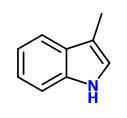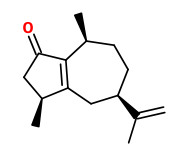Piper nigrum L. - Piper aromaticum Lam. - Piperaceae - common pepper, black pepper, Schwarzer Pfeffer
Perennial woody vine growing up to 4m, native in South and Southeast Asia, cultivated in Asia, tropic Africa, West Indies, Brazil.
„Peppercorns, and the ground pepper derived from them, may be described simply as pepper, or more precisely as black pepper (cooked and dried unripe fruit), green pepper (dried unripe fruit) and white pepper (ripe fruit seeds)…. Piperine, along with its isomer chavicine, is the alkaloid responsible for the pungency of black pepper and long pepper… Piperine was discovered in 1819 by Hans Christian Ørsted, who isolated it from the fruits of Piper nigrum, the source plant of both the black and white pepper grains. The amount of piperine varies from 1-2% in long pepper, to 5-10% in commercial white and black peppers.“ http://en.wikipedia.org/wiki/Piperine
Dilution experiments and enantioselective analysis indicated linalool, (+)-α-phellandrene, (-)-limonene, myrcene, (-)-α-pinene, 3-methylbutanal and methylpropanal as the most potent odorants of black pepper. In a black pepper sample with a mouldy, musty off-flavour, 2-isopropyl-3-methoxypyrazine and 2,3-diethyl-5-methylpyrazine were detected as important odorants.
[Flavour and off-flavour compounds of black and white pepper (Piper nigrum L.) I. Evaluation of potent odorants of black pepper by dilution and concentration techniques., Jagella, T., Grosch, W., European Food Research and Technology, 209(1), 1999, 16-21]
„Quantification of 14 odorants and calculation of their odour activity values were the basis of an aroma model reflecting most of the odour notes of black pepper. Omission tests indicated α- and β-pinene, myrcene, α-phellandrene, limonene, linalool, methylpropanal, 2- and 3-methylbutanal, butyric acid and 3-methylbutyric acid as key odorants. A storage experiment revealed that for ground black pepper, losses of α-pinene, limonene and 3-methylbutanal were mainly responsible for deficits in the pepper-like, citrus-like, terpene-like and malty notes after 30 days at room temperature. The musty/mouldy off-flavour of a sample of black pepper was caused by a mixture consisting of 2,3-diethyl-5-methylpyrazine (2.9 μg/kg) and 2-isopropyl-3-methoxypyrazine (0.2 μg/kg).“
[Flavour and off-flavour compounds of black and white pepper (Piper nigrum L.) II. Odour activity values of desirable and undesirable odorants of black pepper. Jagella, T., and W. Grosch. European Food Research and Technology, 209.1, 1999, 22-26]
A typical unpleasant off-odour, described as fecal, cowshed-like, is often observed in white pepper, but not in black pepper.
„Quantification of 19 odorants and calculation of their odour activity values were together the basis for an aroma model which reflected the odour profile of a white pepper sample having a faecal off-flavour. Omission tests indicated limonene, linalool, α-pinene, 1,8-cineole, piperonal, butyric acid, 3-methylbutyric acid, methylpropanal, and 2- and 3-methylbutanal as key odorants of white pepper. The faecal off-flavour was caused by skatole and was enhanced by the presence of p-cresol. In six samples of white pepper the intensity of the faecal off-flavour paralleled the concentration of both skatole and p-cresol. In the sample with the strongest off-flavour the concentrations amounted to 2.6 mg/kg (skatole) and 12.4 mg/kg (p-cresol).“
[Flavour and off-flavour compounds of black and white pepper (Piper nigrum L.) III. Desirable and undesirable odorants of white pepper., Jagella, T., Grosch, W., European Food Research and Technology, 209(1), 1999, 27-31]
Accelerated Solvent Extracts (ASE) and SFE of green pepper show a different spectrum of compounds than the essential oils. Main volatiles were α-pinene (0.8-4.4%), sabinene (5.6-14.0%), β-pinene (1.8-6.9%), 3-carene (4.3-10.1%), limonene (4.6-7.8%), β-caryophyllene (6.5-26.3%), and elemol (3.3-12.9%); with higher percentages of β-phellandrene (1.2-2.3%), (E/Z)-sabinene hydrate (1.5-3.6%), terpinen-4-ol (2.1-4.5%), α-copaene (1.2-4.8%), δ-cadinene (0.7-3.0%), and δ-cadinol (0.6-3.4%).
[Blum, Carsten. „Analytik und Sensorik von Gewürzextrakten und Gewürzölen.“ (1999)] http://ediss.sub.uni-hamburg.de/volltexte/1999/57/pdf/Dr.Blum.pdf
AEDA analysis of white pepper with very intense off-odour showed highest FD factors for α-pinene and linalool (FD 1024), the off-odorants with high FD factors were 3-methylindole (skatol, fecal-swine-manure, FD 512), and 4-methylphenol (fecal, horse-like, FD 256). 3-Methylphenol (FD 128, phenolic), and the cheesy smelling 2-methyl and 3-methyl butanoic acids (FD 32) were also present. Regardless of the origin these off-odorants are characteristic constituents of white pepper, formed during fermentation. They can be minimised combining a frequent change of water during fermentation with a reduction of the fermentation time to four days, starting with fully ripe fruits.
[Off-flavour formation during white pepper processing., Seinhaus M., Schieberle P., in: State of the Art in Flavour Chemistry and Biology, Ed. Hofmann T., Dt. Forschungsanst. für Lebensmittelchemie, 2005, 197-204]
„An investigation of nitrogen-containing compounds in black pepper oil, by capillary GC, GC/MS and HPLC techniques, revealed 20 previously unreported pyrazines, pyridines and piperidines. These species were found to be present at levels ranging from 150 ppb to 30 ppm. Odor assessment revealed that 2-ethyl-3,5-dimethylpyrazine (1.5 ppm) and 3-ethyl-2,5-dimethylpyrazine (490 ppb) contributed most significantly to the overall odor…
The most abundant of the nitrogenous materials identified were 1-formylpiperidine (28 ppm), 1-acetylpiperidine (22 ppm) and 2,3,5,6-tetramethylpyrazine (7 ppm). The odor character determined by GC-O and odor threshold values (10) revealed that the compounds contributing most to the characteristic odor were 3-ethyl-2,5-dimethylpyrazine (earthy, roasty), 2-ethyl-3-methylpyrazine (roasted, aromatic) and 2-ethyl-3,5-dimethylpyrazine (roasted green vegetable, coffee and cocoa note).“
[Nitrogen-Containing Compounds in Black Pepper Oil (Piper Nigrum L.), Clery, Robin A; Hammond, Christopher J; Wright, Anthony C., Journal of Essential Oil Research, Vol.18 (1), 2006, 1-3]
„A simple, rapid and solvent-free method based on gas chromatography-mass spectrometry (GC-MS) following microwave distillation and headspace solid-phase microextraction (MD-HS-SPME) was developed for the analysis of the essential oils in two traditional Chinese medicines, Piper nigrum L. and Piper longum L. Thirty compounds were separated and identified from P. nigrum L. The main components were β-caryophyllene (23.49%), 3-carene (22.20%), d-limonene (18.68%), β-pinene (8.92%) and α-pinene (4.03 %).“
[GC-MS Analysis of the Essential Oils of Piper nigrum L. and Piper longum L., Liu, L., Song, G., Hu, Y., Chromatographia, Vol.66(9-10), 2007, 785-790]
„An obscure sesquiterpene, rotundone, has been identified as a hitherto unrecognized important aroma impact compound with a strong spicy, peppercorn aroma. Excellent correlations were observed between the concentration of rotundone and the mean 'black pepper' aroma intensity rated by sensory panels for both grape and wine samples, indicating that rotundone is a major contributor to peppery characters in Shiraz grapes and wine (and to a lesser extent in wine of other varieties). Approximately 80% of a sensory panel were very sensitive to the aroma of rotundone (aroma detection threshold levels of 16 ng/L in red wine and 8 ng/L in water). Above these concentrations, these panelists described the spiked samples as more 'peppery' and 'spicy'. However, approximately 20% of panelists could not detect this compound at the highest concentration tested (4000 ng/L), even in water. Thus, the sensory experiences of two consumers enjoying the same glass of Shiraz wine might be very different. Rotundone was found in much higher amounts in other common herbs and spices, especially black and white peppercorns, where it was present at approximately 10000 times the level found in very 'peppery' wine. Rotundone is the first compound found in black or white peppercorns that has a distinctive peppery aroma. Rotundone has an odor activity value in pepper on the order of 50000-250000 and is, on this criterion, by far the most powerful aroma compound yet found in that most important spice.“
[From wine to pepper: rotundone, an obscure sesquiterpene, is a potent spicy aroma compound. Wood, C., Siebert, T. E., Parker, M., Capone, D. L., Elsey, G. M., Pollnitz, A. P., Herderich, M. J., Journal of agricultural and food chemistry, Vol.56(10), 2008, 3738-3744]
Mean rotundone concentration was found 2025 μg/kg in white pepper and 1200 μg/kg in black pepper.
[Wood, C., Siebert, T. E., Parker, M., Capone, D. L., Elsey, G. M., Pollnitz, A. P., Herderich, M. J. (2008). Spice up your life–The Rotundone story. Expression of Multideisciplinary flavour science, Proceedings of the 12th Weurman Symposium.] https://home.zhaw.ch/yere/pdf/Teil121%20-%20Expression%20of%20Multidisciplinary.pdf
Black pepper essential oil obtained by supercritical fluid extraction (SFE) using carbon dioxide had higher levels of sequiterpene hydrocarbons, leading to higher sesquiterpene to monoterpene ratios, than essential oil obtained by hydrodistillation. Main compound of the CO2-extract is β-caryophyllene (12%), followed by caryophyllene oxide (8%), limonene, α-copaene, elemol (each 6%), sabinene (5%) and δ-carene (5%). Main compound in the hydrodistilled extract is caryophyllen oxide (12%), with β-caryophyllene only 2%, limonene (6%), α-copaene (5%).
[Extraction of Sarawak black pepper essential oil using supercritical carbon dioxide. Kumoro, Andri C., Masitah Hasan, and Harcharan Singh. Arabian Journal for Science and Engineering Vol.35 (2), 2010, 7-16] http://ajse.kfupm.edu.sa/articles/352B%20p.01.pdf
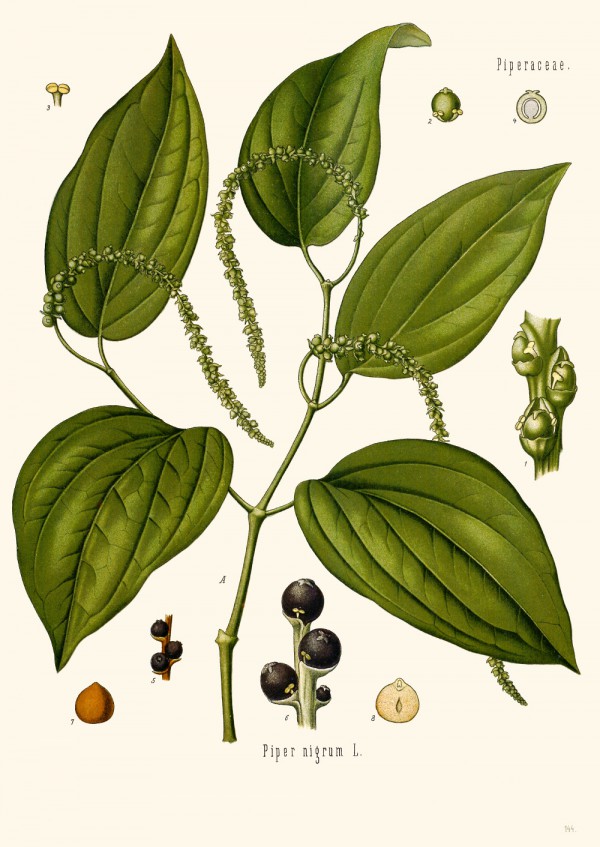
Köhler, F.E., Medizinal Pflanzen, vol.2, t.144 (1890) plantgenera.org
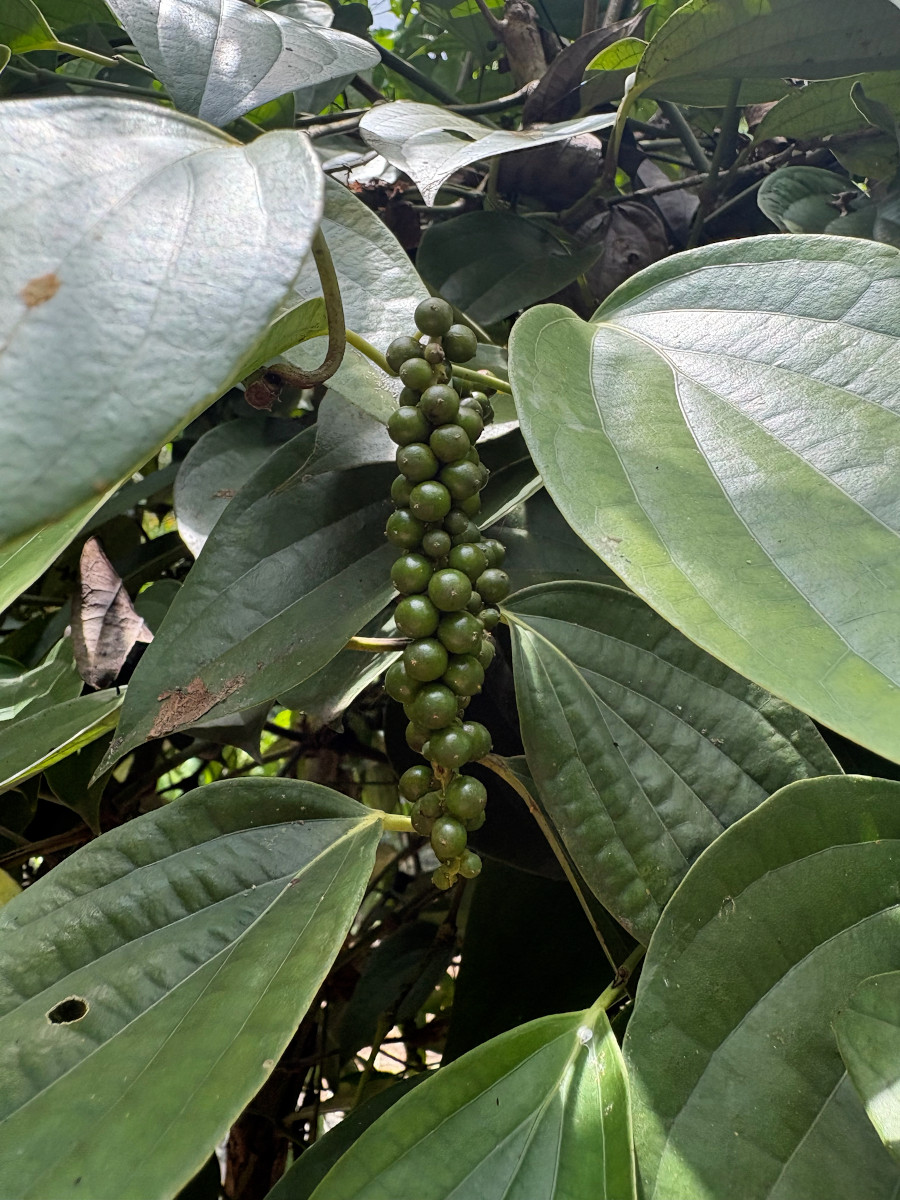
Piper nigrum, Flores, East Nusa Tenggara, Indonesia (2025) © Vincent Schieveen CC BY-SA 4.0 inaturalist.org
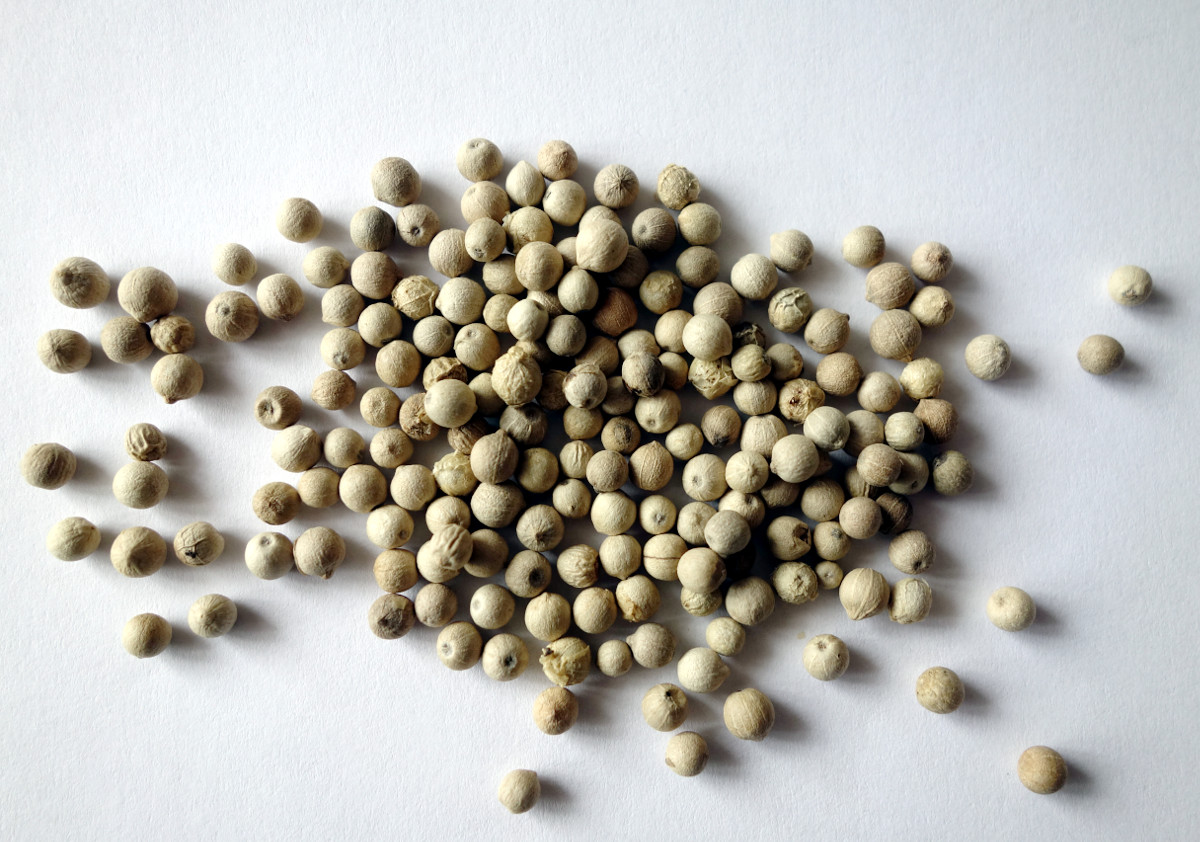
Muntok white pepper, CC BY-SA 3.0, Author: Andreas Kraska




